[This article contains photographs and descriptions of injecting.]
I‘ve been using opioids for 20 years, but injecting didn’t become my regular route of administration until 2019. I’d just come cold turkey off benzos, one week of death—vomiting, visual hallucinations. And newly unmedicated anxiety and ADHD, which in hindsight was the real reason I switched from sniffing to shooting. I needed things to hit harder.
No disrespect to the 27 gauge needles everyone’s used to, but I want no part of them. I’ve never liked needles. Plenty of people who shoot three bundles a day have never liked them. Outside the neighborhood, most people in my life—family, friends—didn’t know I’d started shooting, and I wanted it to stay that way. Meaning: no track marks. Hence, the 31 gauge short-tips—you know, the ones with the 5/16″ needles, not the 1/2″. The needle so thin you almost can’t see it.
Their reputation is that they bend, they break, they clog. They’re too short to reach a vein. They’re so narrow you’ll miss your shot if even you do reach a vein. They’re only suitable for hands and feet.
For me, the obvious benefit is no tracks. But reducing the diameter of the holes in your skin also reduces risk.
But bending and breaking can be mitigated. Used properly, 31s don’t clog much more than the 27s. I’m less worried about a 5/16″ needle not reaching a vein than I am about a 1/2″ inch one going all the way through. To me, it seems easier to thread a small needle into a vein than a bigger one, but to each their own. And you can use short-tips anywhere you can find a topical vein—not just hands and feet.
The main barrier for almost everyone I’ve talked to about 31s—other than maybe the assumption about hands and feet—is that they just don’t know how to use short-tips, and they’re used to the 27s so it never really occurred to them to ask. No one I knew used them when I started out, either. But I was fortunate enough to have stable housing (at the time, anyway) where I could take the time to learn my veins, and that was enough.
For me, the most obvious benefit is no tracks. But reducing the diameter of the holes in your skin also reduces risk of infections and scarring. And it also means that whenever the 27 gauges are in short supply, you won’t be without options. Never a shortage on short-tips, at least in my part of the East Coast.
Backloading
Short-tip needles are delicate, soft. They dull at the slightest touch, which is why the first surface they ever touch should be your skin, not a metal cooker.
I do use the 27s (or whatever larger-gauge needle is around), just not to inject. I use them to draw up the liquid dope from the cooker. Then instead of injecting it into a vein, I backload it into a 31. Boom—now your dope’s in a syringe with a mint-condition sharp that hasn’t touched so much as a cotton.
Pound a bottle of water, whether or not you think you’re hydrated. Then take an EasyTouch 27g .5cc, or anything with a plunger and barrel the same size as the 31s. Draw up with your 27. Keep the bevel facing down so it doesn’t dull any more than it has to; we’ll get to that in a minute. Leave at least a few units of airspace. Pull the plunger out from your 31. Put the 27 syringe in its place. Plunge. Make sure to keep the 31 tip angled down slightly, so you don’t lose your shot while the barrel is still open at the other end.
Once you’ve transferred your shot, put down the 27—don’t bend the needle or anything, remember we’re not done with it. Take the plunger you’d set aside and reposition it, pushing in just far enough to reform the seal with the barrel so you don’t have to hold them together. Turn the whole thing upright.
This is why you want airspace—otherwise the plunger will be pushing out precious units of dope, not air. If you only used enough to fill the barrel partway though, you can just turn the needle upright and suction will prevent any from falling out. Flick until all the bubbles are at the top, then slowly plunge to close airspace. Done right, you’re not losing more than two drops. Use an alcohol prep to—gently—wipe off the outside of the needle. Not the tip. Give the alcohol a few seconds to dry.
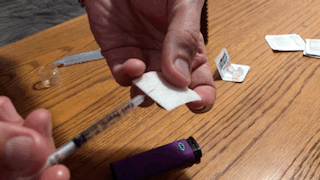
Back when I started I’d usually hit my upper arm, because I didn’t have the control or knowledge of my own veins to go anywhere else. These days, I usually go with lower leg. I always wipe the injection site with an alcohol prep—one direction, not back and forth—and I always shoot toward the heart, bevel up.
Don’t worry if your veins don’t exactly pop like that. You don’t find them by sight—you find them by touch. If you feel the vein suck in the needle, you know you’re really on. When it gets picked up by the current.
If you’re dehydrated, dopesick or still learning your veins, try feeling for one along your calf. You can use a tourniquet to tie off below the knee. Once you register, wait a couple of seconds, then go.
This shot I went in almost perpendicular. Not because that’s advisable, but because I know my veins and it felt like the right angle for this one, and it was—perfect shot. That’s just how it goes sometimes.
If you’re unsure, stick with something between 15 and 45 degrees. You can still go through the vein with needles this short; I’ve done it before. Not often though. Not as often as I see people go through with the 1/2″ tips.
Wait a few extra seconds before withdrawing the needle, ideally while you or someone else holds a benzalkonium chloride wipe or gauze over the site. Don’t use an alcohol pad, it’ll just make the opening take longer to close.
Every once in a while I’ll get dope where the actual fentanyl dissolves fine, but something in the cut isn’t quite water-soluble, and even with multiple cottons will clog a 27. Xylazine can do that, too. Even if you don’t usually cook your dope, it might help when the mixture in the cooker looks looks thicker than usual. Cook twice, if there are still undissolved solids after the first pass.
Wounds on hands and lower legs may be higher-risk for xylazine complications relative to other parts of the body, so keep a close eye on whether they’re healing the way they should.
I know we’re all still figuring out xylazine harm reduction, and I’ve heard short-tip needles could increase wound risk by shortening the distance between the opening in your skin and the site where the drug is deposited. But done carefully, without being rushed, short-tips vastly reduce the size of the wounds that xylazine could turn bad. That’s been the risk reduction in my experience.

Last thing: The used 27 from earlier—no harm in reusing it, so you can cap and save for later. I’ll burn one side, so I know which is which when I’m carrying it around with 31s. You’d think EasyTouch would realize these things shouldn’t be impossible to tell apart without taking the caps off, but that’d make too much sense, right?
Images courtesy of Kastalia Medrano
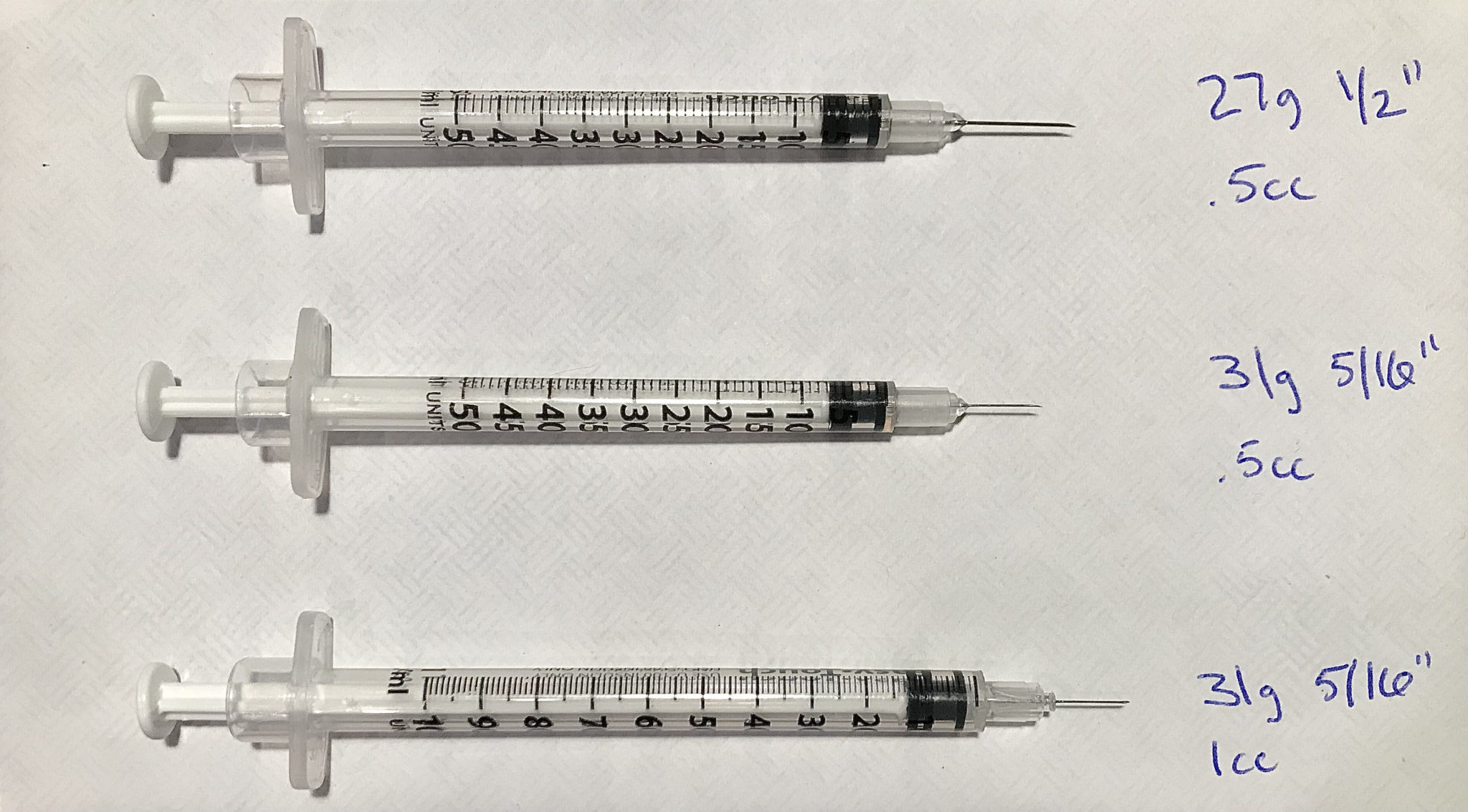
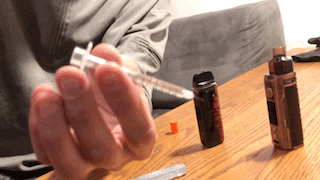
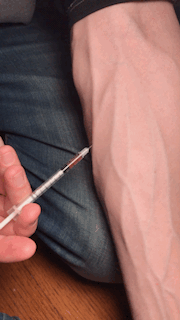
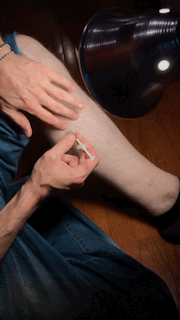





Show Comments